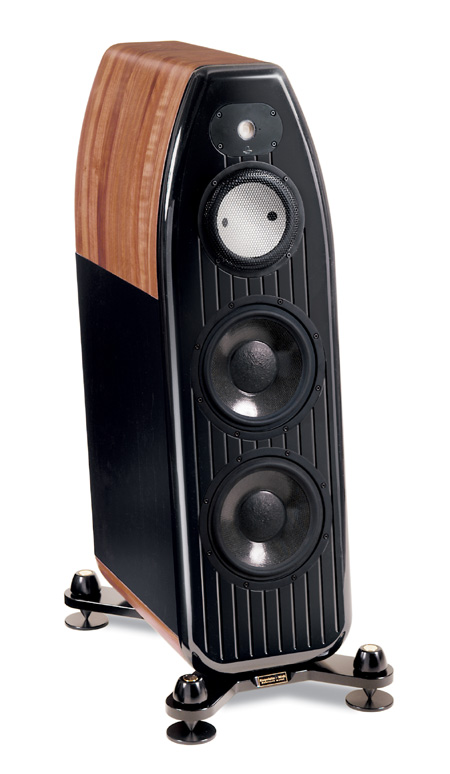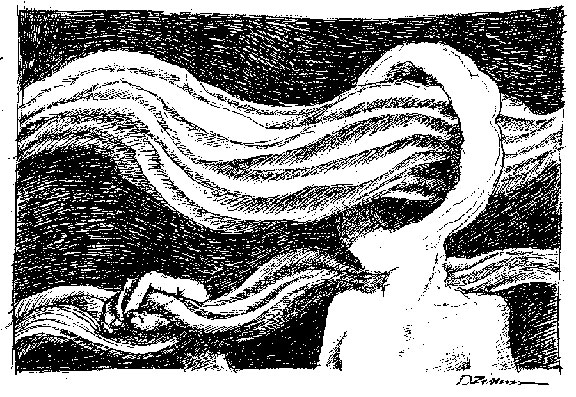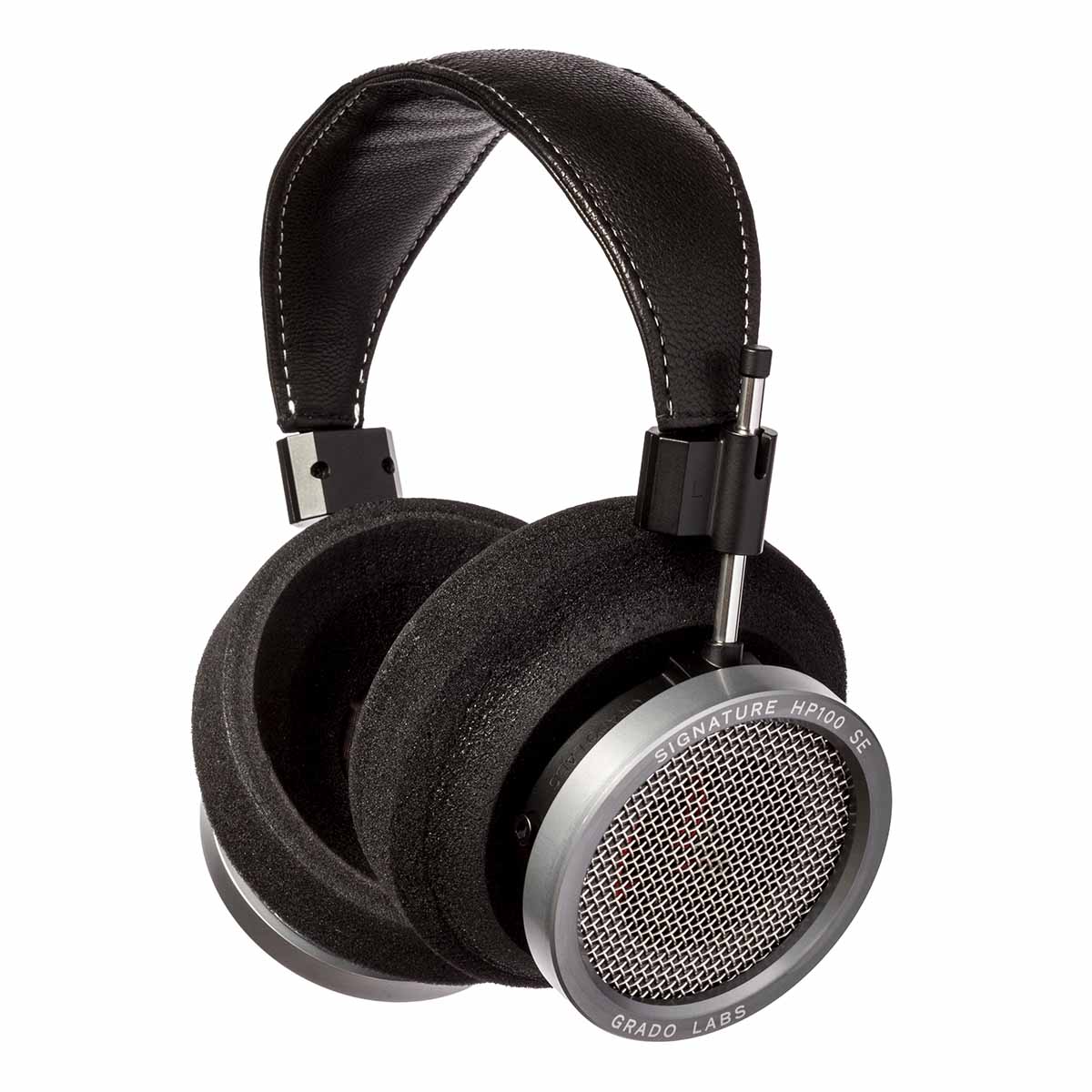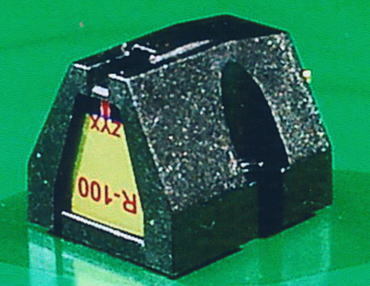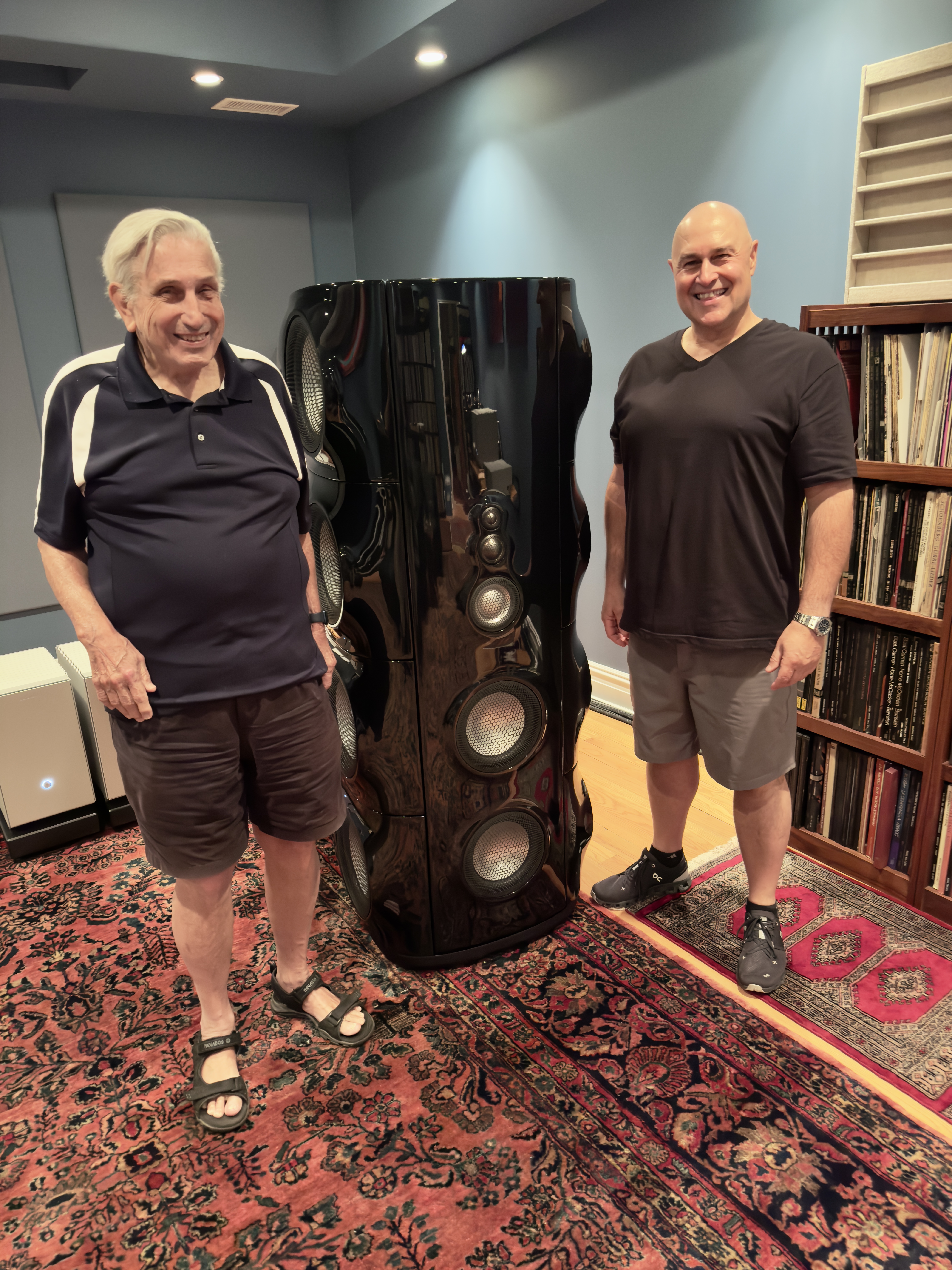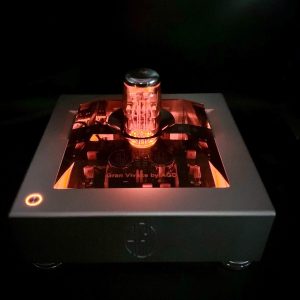This article, by Carol Clark, Victor Chavira, and Larry Cox, originally ran when audioMusings was in print - Issue 3, 1998
I met Gilbert Yeung, president and founder of Blue Circle Audio, at the Hi Fi '97 show in San Francisco. When I ran into him again at CES this year, he agreed to send us some products for review, and I couldn't wait. I was impressed with Blue Circle for several reasons. Gilbert is a great guy, the product is incredibly beautiful to look at, and from what I heard at both shows, it sounded awesome. I liked the rest of the Blue Circle group, too. Some of the companies we visited treated me like the tag-along wife, but not Blue Circle.
I'll review the BC6 amp in a future issue. I was more interested in the BC3 preamp because I was so impressed with the Rogue 66 tube preamp (reviewed in Issue 1), and was anxious to hear how the BC3 would perform in comparison. As with all Blue Circle products, this preamp is very pleasing to look at. The case is brushed stainless steel, has that mystical glowing blue circle in the front, and those big wooden knobs, two of each because it's a dual monoblock preamp. The cosmetics add to the enjoyment of the product for me. The glowing circle is a point of reference in our otherwise dark listening room. The knobs not only feel solid, but are beautiful as well.
Before I discuss the sound of the preamp, let me digress a moment to my youth. In the late '70s, before I knew I was an audiophile, I used to buy a lot of records. Remember how satisfying it was to tear the cellophane off the record jacket? With the large format, the jacket became a work of art (sometimes), and there was plenty of room for liner notes. Some artists used to print instructions on their jackets. One such record was Steve Hackett's Please Don't Touch. I loved this record, and played it as loud and as often as I could. The title track is on side two. In fine print after the song title are the words, "For maximum effect this track should be listened to as loudly as possible with as much treble and bass as your system can muster. Not to be played to people with heart conditions or those in severely hallucinogenic states of mind." My system wasn't that good, so I never had hallucinations while listening. I guess I never understood what this admonishment to play music loud was all about, other than a way to drive my parents crazy. I think it's safe to say that after listening to the BC3, I finally understand.
No, I didn't listen to Steve Hackett. First of all, as I said, I listened to the record a lot in the '70s, when my system wasn't very good, and I'm sure the record is shot. However, I did listen to Nine Inch Nails' The Downward Spiral. This CD doesn't have instructions to listen to it loud, but it should, and the song "Closer," in particular, should carry a warning. I know that this song has pretty offensive lyrics, but as I've said before, it provokes an emotional response in me. For the record, this is not because of the lyrics. Although I listen to the way the singer's voice sounds, I don't listen to what he's saying.
There was always something else about the song, and listening with this preamp, I could finally hear what it was. This song is recorded in lots of layers. I remember listening to it once with a Hsu subwoofer in our system. It was so overpowering, I had to turn it off because I felt like the music was walking over me. With this preamp, it was almost overpowering again, but this time not in a negative way. The song seemed to undulate out of the speakers.
There's one part where I felt like I could see the music swelling in ever-growing waves, longer waves against the floor, shorter waves near the top of the speakers. The next song on the CD, "Ruiner," was equally captivating. I wish I could describe this better, but words escape me.
Highs sounded sweet and natural. (Yes, I did listen to other music besides NIN.) Lows were low and clear, like thunder off in the distance. Vocals were incredibly natural. What was most impressive, however, was the 3D imaging. I've heard components offer depth, width, and height before, but not in the way this unit does. Other preamps reproduce music so that it sounds like a picture projected on a screen. This preamp projected the music out toward me, like I was part of the performance. In case you haven't caught on by now, I really liked this preamp, and they had to pry it out of my hands to pass it along to the next reviewer.
One other recording I listened to extensively was Sky Cries Mary's This Timeless Turning. This CD is from 1994, and is still my favorite recording by this band. I listened to tracks one through seven, and was more and more impressed as it went on. There are all kinds of music represented here, from swirling walls of sound with Middle Eastern overtones ("Shipwrecked"), to delicate acoustic guitar and breathy male/female duos ("These Old Bones"), to hard rocking sounds ("Scapegoat"), to electronic sounds ("Every Iceberg is Afire"). I liked them all, and the BC3 kept up, never missing a beat when the sound of the music changed. It handled the delicate tunes with as much ease as the harder-edged ones. At times, I thought maybe they recorded this CD live in the studio. I checked, and there is no mention of this in the notes, so I e-mailed the band. Ben Ireland, the drummer, was kind enough to respond, to say that parts of it were recorded live in the studio, with the vocals added later. During "Shipwrecked," the details were so incredible, I swore I could hear the female vocalist turning her head as if to look at the male vocalist. The music seemed to come out so far into the room that I could feel it touching my feet. What I look for in a system is "in your face" sound. I don't want to hear the music at or behind the rear wall. Remember in my bio (Issue 1), where I said I like to smell the sweat of the performers? This preamp put the sweat right in my face. The projecting sonic images added a new level of enjoyment to everything. It covered all ranges of the musical spectrum. I did notice on some of my favorite old songs that it was a bit revealing of poor recordings. I'm willing to overlook that, though, because it more than made up for it with the well-recorded pieces.
Afterword: I listened to Sky Cries Mary again with our usual setup. Here's my analogy—listening to the disc with our setup was like watching a concert from nose-bleed heaven compared to listening with the Blue Circle, which was like watching the concert from the mosh pit. I could still hear what a beautifully recorded disc this is, but I felt like I was leaning over a railing to try to hear it instead of having it surrounding me. Dave and I liked this preamp so much, we've decided to purchase one. Carol Clark
It is one of the bizarre, but completely understandable parts of this audio obsession/hobby, that we fantasize about certain pieces of gear because we project that these components will change everything for the better, i.e., that our systems' strengths will remain as their weaknesses disappear. This kind of wishful thinking explains why many of us change gear like underwear, while perennially believing that we have reached a place of stasis. The fact is, stasis doesn't happen too often. Given this, I wonder whether the audiophile thing is less about enjoyment than about trying to rub shoulders with the elusive notion of "perfection."
This brings me to the Blue Circle preamp under review. This preamp is a really different pup than my E.A.R. 802. Not only does it have big, ostentatious, cherry-wood orbs for the volume and selector knobs, unlike the understated and perhaps bland appearance of the E.A.R., but the Blue Circle has that big blue eye staring out from its stark stainless steel panel. I'm ambivalent about the BC3's appearance. In part I admire the boldness of the visual design— too much of audio is run by conservative bores with little or no aesthetic sense. On the other hand, I don't like the way it looks. On balance, I prefer an understated look, and don't really want my stereo crying out for visual attention.
The BC3 has excellent extension at both frequency extremes. It is an exceptional bass performer. I really enjoy recordings with good bottom end. There is something special about feeling bass hit your chest, or even blow a soft breeze at your pant legs. The Blue Circle preamp will certainly do this. At the top end, the BC3 is among the most extended I've had in my system, with good retrieval of top end information, without being etched or hard, and a reasonable, although not excellent sense of air around instruments. There is plenty of detail for the detail hounds. The top end is not tipped up, but quite firmly part of the musical presentation.
The preamp's other great strength is its transparency. After inserting the BC3 into my system, my first response was, "Damn! I've got a dull old lady for a preamp." The E.A.R. tends toward the laid-back, mellow, and perhaps even classically "tube" side of sound. The Blue Circle is WAY more present.
Perhaps the E.A.R. isn't a great choice for a transparency comparison. It requires that you listen into the music, although with that small change of orientation, there is lots of detail. It just isn't thrown at you, as it is by the Blue Circle.
However, all of the Blue Circle's excitement comes at a cost. After going back and forth between the Blue Circle and my preamp several times, my initial disappointment in the E.A.R. and envy of the Blue Circle evaporated. I noticed that not everything was A-OK with the BC3, and quite a bit was A-OK with the E.A.R. Yes, the Blue Circle is faster and more extended and a bunch of other things, but what it doesn't do as well as the E.A.R. is the sustained note. For some peoples' taste in music, this won't really be a problem. For me, it is. I tend to like music with a melody, and enjoy acoustic more than electrified music. I can and do enjoy performers like Beck, but don't make high fidelity demands when listening to that kind of music.
After my listening period was done and my notes were complete, I heard the BC3 in Dave and Carol's system, where it is a better match for their tastes in equipment and music. The BC3 grabbed hold of the bottom end of the Apogees and made them taut, although I found the bass a bit overdone. In their system, I heard a similar problem with the BC3 that I heard in mine—lots of attack and decay, but a slighting of sustained tone. For Dave's music, I think this would be acceptable, but not for me and my kind of music. The BC3 is just not my cup of tea. Larry Cox
Blue Circle's room in the Alexis Park at this year's CES stands out in my memory. Visitors were greeted by the distinctive look and sound of Blue Circle's hybrid wares. The BC3 is the Canadian manufacturer's dual-mono line stage.
The BC3 is large and heavy, much of the bulk due to its stainless steel shell. Since stainless steel rings like a bell, the inside of the body is damped with Dynamat®, popularly used in auto installation systems. This attention to resonance damping is evident throughout the BC3, in fact thourghout all Blue Circle products. The top of the BC3 is easily removed, giving access to a pair of 6922 tubes. The entire circuit is mounted on a clear blue acrylic board, which is then spring-mounted to the bottom of the body. Wires and parts are secured to the blue board with liberal amounts of acrylic glue. The BC3 makes extensive use of top-shelf parts. Large yellow Musicaps® are proudly displayed. The circuit is entirely hand-soldered, point to point. From the inside, the BC3 is reminiscent of homebrew designs, although implemented to a very high standard.
The outboard power supply, which has a removable AC cord, is connected to the control unit by a three-foot braided cord. The front of the control unit has four large wooden knobs in a dual-mono arrangement. One knob is a stepped attenuator that makes a solid clicking sound when adjusting the volume. The other knob is for selecting sources 1, 2, 3, or 4. The knobs are available in a variety of beautiful Canadian hardwoods. Our sample came with dark cherry. By far, however, the most distinctive aspect of the BC3's physical appearance is the bright blue circles that illuminate when the unit is powered.
If you thought gazing at hot orange bottles at night was sensual, wait till you get a load of this. The effect can be downright hypnotic. The BC3 was installed in the usual location of my 20' by 13' living/listening room. The unit has already been broken in by other audioMUSINGS partners. The BC3 inverts polarity, so I had to reverse my speaker leads. Just to recap, I normally drive my Anthem Amp1 directly from the variable output of my Audio Electronics CD1. Now, the signal from the CD player was routed to the BC3 with a half meter pair of Nordost Blue Heaven.
I was suprised to hear that the BC3 didn't sound particularly "tubey." That is, it didn't sound warm or lush. Rather, it sounded neutral on all the recordings I played. Even with its neutrality, though, the BC3 conveyed richly-saturated tonal colors without being overly bright.
Lately, the most popular disc in my collection has been Killer Tumbao by Cuban pianist Hilario Duran, a well-recorded disc that features some rousing Latin jazz. The BC3 drew me into the music with its ability to present inner details and the harmonics of acoustic piano and percussion. Horn blasts sounded true to life, with each instrument retaining its individuality. Track nine is a descarga, a jam, that features both acoustic and electric bass. Here I began to notice a lean quality to the bass, as if the bass players had softened their callouses. Other discs demonstrated this characteristic as well. Switching back to using the CD1 direct revealed a more rounded and open low-bass perspective. Perhaps another interpretation of this is that the BC3 is tightening lower bass harmonics.
The BC3 also demonstrated excellent retrieval of ambient information, as expected in a tube design. The soundstage was wide and deep, with clear contrasts between instruments and musicians on the stage. String sections were also well served by the BC3. Some line stages can make strings sound hard and dry, whereas others reproduce string tones with too much color. The BC3 did neither. Again, neutrality was the name of the game. I do believe, however, that the BC3's harmonic complexion would change with different tubes. That's one of the advantages of owning tube equipment. With its homebrew influences and easy accessibility to the tubes, the BC3 invites such experimentation.
All in all, the BC3 was fun to use and presented music cleanly. At $3300, the BC3 is pricey and faces stiff competition, but if you are a person with an eye for something different, and are looking for a line stage that will surely become the centerpiece of your system, the BC3 deserves your attention. Victor Chavira
Blue Circle BC3 preamplifier
Retail $3300
Blue Circle Audio





